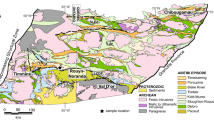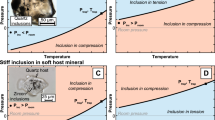Abstract
The nature and abundance of dislocations in quartz surrounding fluid inclusions were studied to obtain a better understanding of processes associated with fluid inclusion reequilibration. Synthetic fluid inclusions containing 10 wt% NaCl aqueous solution were formed in three samples at 700 °C and 5 kbar. One of the samples was quenched along an isochore to serve as a reference sample. The other two samples were quenched along a P-T path that generated internal pressures in excess of the confining pressure. The two samples were held at the final reequilibration P-T conditions of 625 °C and 2 kbar for 30 and 180 days, respectively. Following the experiments, microstructures associated with fluid inclusions were examined with the TEM. Quartz in healed fractures in the reference sample that was quenched isochorically shows a moderate dislocation activity. Quartz adjacent to reequilibrated fluid inclusions in the other two samples, however, showed a marked increase in dislocation activity compared to the un-reequilibrated sample. Deformation of the inclusion walls occurred anisotropically by expansion of mobile dislocations in their slip systems. Dislocation expansion was controlled by glide in the rhombohedral planes {1 0 1 1} that was restricted to narrow zones (≤3 μm) in the immediate vicinity of the fluid inclusion walls outside of the healed fracture plane. These plastic zones were observed after both short term (30 days) and long term (180 days) experiments and are attributed to hydrolytic weakening of quartz around fluid inclusions owing to diffusion of water into the quartz matrix during the experiment. The close spatial association of submicroscopic water bubbles with dislocations, and the rarity of water bubbles in the reference sample, show clearly that in both the 30 and 180 day experiments reequilibration involves water loss from the fluid inclusions. Our results indicate that synthetic fluid inclusions in this study recover (chemically and volumetrically), even at relatively fast experimental loading rates, such that internal stresses never reach the point of brittle failure. The driving force for fluid inclusion deformation involves two related mechanisms: plastic deformation of hydrolytically weakened wet quartz in the healed fracture, and water leakage associated with preexisting and strain-induced dislocations.
Similar content being viewed by others
Author information
Authors and Affiliations
Additional information
Received: 5 May 1998 / Accepted: 10 February 2000
Rights and permissions
About this article
Cite this article
Vityk, M., Bodnar, R. & Doukhan, JC. Synthetic fluid inclusions. XV. TEM investigation of plastic flow associated with reequilibration of fluid inclusions in natural quartz. Contrib Mineral Petrol 139, 285–297 (2000). https://doi.org/10.1007/s004100000142
Published:
Issue Date:
DOI: https://doi.org/10.1007/s004100000142




